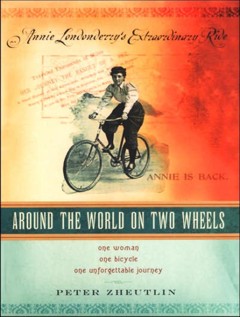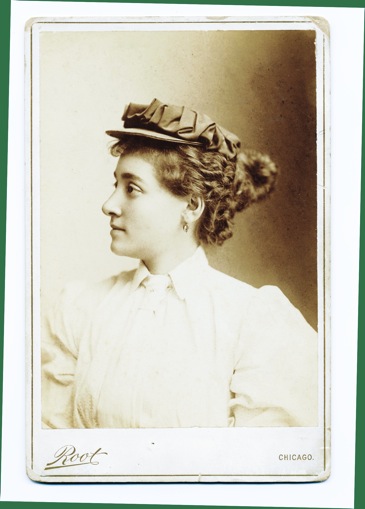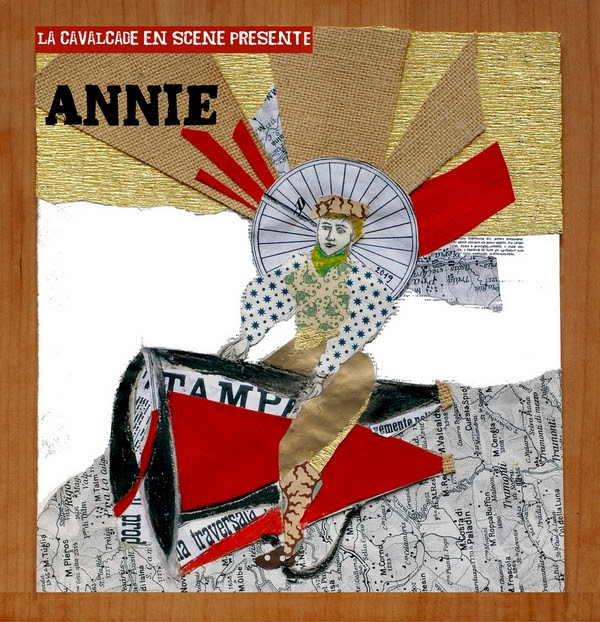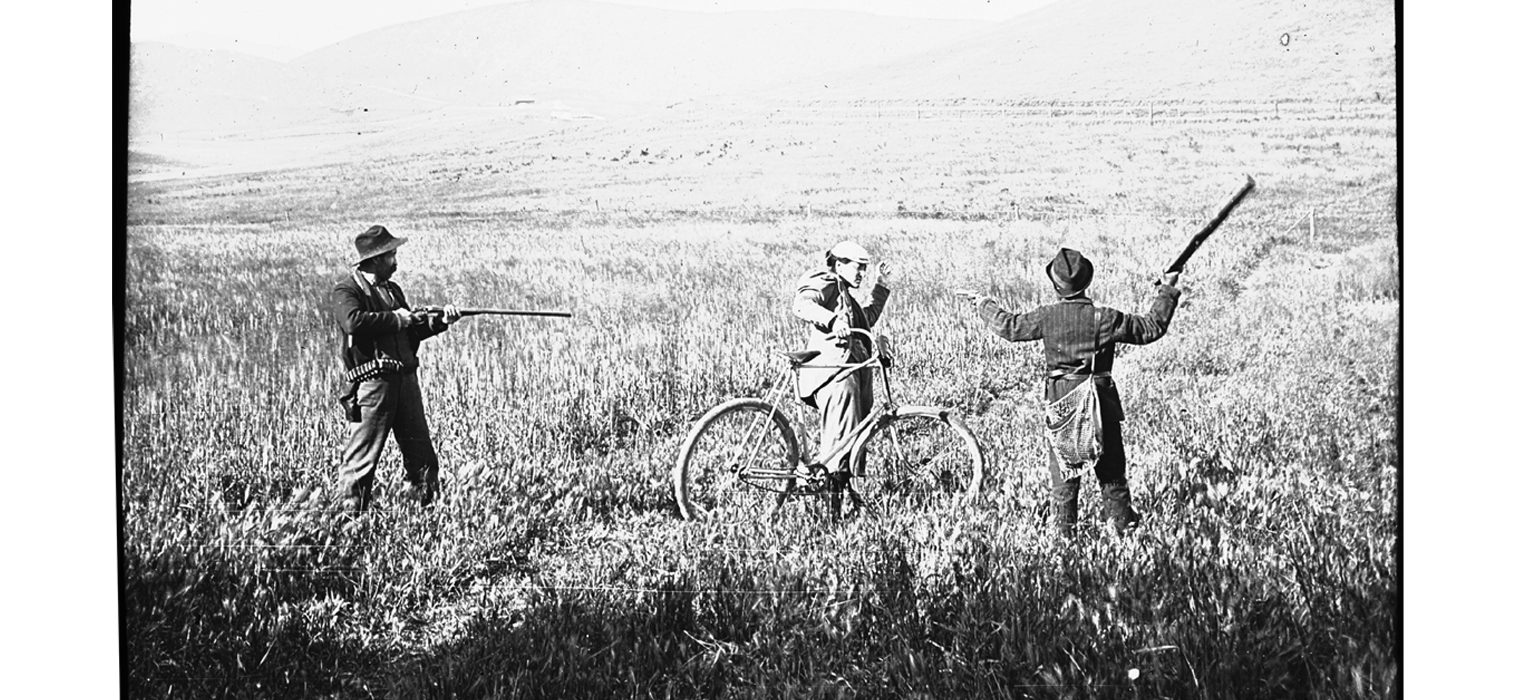Annie Cohen Kopchovsky, première femme à vélo autour du monde en 1894-95! En français et in english
Publié le 28/04/2020
A l’hiver 2007-2008, je me trouvais pendant trois mois à Lhassa, au Tibet. La révolte des Tibétains-nes contre le joug chinois culmina le 10 mars 2008. La répression fut terrible et depuis, la situation est restée intenable.

Pendant la soixantaine de jours durant lesquels que je soignais ma pneumonie aiguë, je fis envoyer de nombreux livres. Je découvris le croustillant récit, critique et bien contextualisé, de Peter Zeuthlin consacré au tour du monde de son arrière grande-tante, Annie. J’entrai en contact avec lui et consacrai plusieurs écrits à son livre, dont le dernier en date, Partie en jupe, revenue en pantalon (La Liberté, 23.04.2020):


La parution de son livre, en anglais, (d’une façon incompréhensible jamais encore traduit en français) a donné lieu à la publication d’un fanzine des Dérailleuses, ainsi qu’à de nombreux spectacles, dont celui de Marialice Tagliavini :

Article translated from French into English by John Weiss:
Annie Cohen Kopchovsky was the first woman to cycle around the world — 1894 and 1895.
Departs in Skirt, Returns in Pants
In October 2003, Peter Zheutlin finally finds Mary, 72-year-old Annie’s granddaughter, who says of her grandmother that she was « an inveterate storyteller, of an outrageous character, who had a relationship very episodic with the truth. » Once restored, the truth is no less extraordinary: Annie Londonderry (this is her traveler’s name) figures at the pantheon of adventurers biking.
A challenge met on June 25, 1894, Annie, daughter of Boston Jewish immigrants from Riga in Latvia, from very modest means, leaves her husband and three young children for riding a bicycle of 19 kg. Her goal: to achieve nothing less than to be the first female to go around the world by bike! And it was less than a decade after it was first done (actually on a high wheel) by the Englishman Thomas Stevens. A bold initiative that she took in response by a bet by two wealthy businessmen from Boston who swore that a woman could never accomplish such a feat. Annie will not only have to prove her physical strength, but also her resourcefulness by making 5000 dollars during her journey.
The two men agree to pay her double, 10,000 dollars, a tremendous sum for the time (the price of a 3rd class ticket on the Titanic was 50 dollars). The mind is inspired by Jules Vernes and his famous World Tour in 80 days published in 1872.
Annie Cohen Kopchovsky was just 23 years old and did not have a kopeck. Upon departure, a representative from Columbia Bicycles provides a bicycle. The Londonderry Lithia Spring Water Company offers her 100 dollars to place an advertising panel on the back of her bike and requires her to display the name of the company during her travels. Annie will henceforth be called Londonderry and at the same time avoid the use of her Jewish name, which was not always well received.
A pioneer who ignores herself, she then begins professional cycling by introducing the first advertisement in the field of cycling, that even today covers professional runners from head to toe. She will also have the presence of mind to buy glass plates (souvenir photos of the time), in order to flesh out her lectures with “magic lantern » slides. There too she shows flair and modernity: this way of earning money will be widely practiced then by athletes and travelers. Annie Londonderry is indeed an avant-garde character in an era of economic depression, the bicycle boom (bikes are sold by the millions), senseless bets, planetary journeys and the emancipation of women.
Peter Zheutlin’s affectionate, journalistic eye doesn’t miss his heroine’s deviations from the truth. The author of the book recounting Annie’s adventure finds picturesque and sometimes painful details of her family tree and allows the reader to get a good idea of the Victorian era. In the 1890s, doctors clashed over whether cycling was harmful or, on the contrary, beneficial to the so-called weak sex and whether it was unlikely to give her any ideas! Conversely, bike manufacturers and visionaries dreamed of a new clientele.
A liberated woman with a fertile imagination
The truth of the facts reported by the American pioneer is questioned today.
Quickly, Annie Cohen Kopchovsky dropped the heavy Victorian skirts to put on the famous bloomers more practical for riding a bike with a man’s frame. She rejects the corset in favor of a thick sweater and armed with a gun. She ignores the principles of the morality of the time without becoming, however, an activist feminist. If one of her detractors describes it as part of the « third sex », her admirers regard her as a New Woman. In reality, historians today agree that Annie would have done nothing to promote female emancipation. She was simply a pure opportunist. It is not less true that with her, the image of the liberated woman then eroticism displayed now on advertising posters for cycling. And that she departed on a single speed bike with a rudimentary brake — for glory, money and freedom.
Arriving in Le Havre by steamboat in November 1894, Annie Cohen Kopchovsky reached Paris by train and crossed France by bike to Marseille. Often escorted by a horde of cyclists, she arouses popular jubilation. The newspaper stories tell of her fantastic adventures, often born of her fertile imagination: the attack of hooded men, a tiger hunt in India, the meeting of gulag prisoners in Siberia. She was also at, according to her, the forefront of the Sino-Japanese War. But the dates contradict her story and the distance pedaled.
Back then, journalists from Singapore questioned the veracity of the actions of this daring woman, who spent half her time on ocean liners. The Los Angeles Times of May 29, 1895, wrote about her when she arrived in that city, without even mentioning her name — « Scarcely a week passes in which some person does not turn up who is bumming his way around the world on some asserted big wager that he will do it in a certain length of time, and sometimes in addition that he will collect so much money on the road. This style of beating one’s way is getting very stale and rather tiresome. Of late even the ‘coming woman’ has gone into this line of business.” In reality, she would have cycled 14,587 km over 41,843 km. No newspaper mentioned her return. Having abandoned them for almost fifteen months, Annie Londonderry was despised by her extended family and they never again spoke her name!

